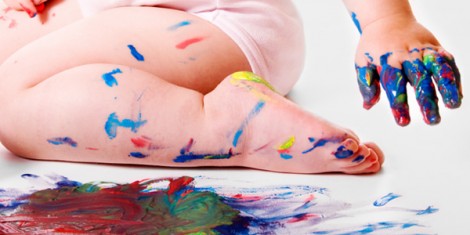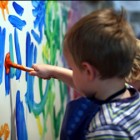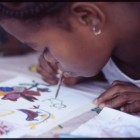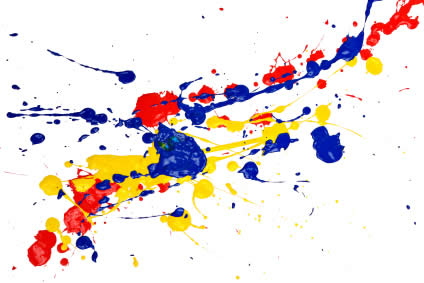
It’s April! Welcome to a happy month of spring flowers, dancing in the sun and finding things to do over the Easter holidays. This month we are looking at Crafty Parents – yes, it is our very, very clever play on words where you are the crafty ones for finding cool activities to entertain your kids over this period.
So it is most fitting that we look at colour in this feature. Why is it so important that our children learn to colour in? When do they first recognise colours? When do they start colouring in and what inspires them to do so?
What value is there in colour?
 It was very interesting doing the research for this and the website DLTK Growing Together has some extremely interesting points if you'd like to explore further. To start with colouring is a great way to develop your child’s manual dexterity.
It was very interesting doing the research for this and the website DLTK Growing Together has some extremely interesting points if you'd like to explore further. To start with colouring is a great way to develop your child’s manual dexterity.
Learning to hold a pencil or crayon between those adorably chubby fingers does wonders for their motor skills – building finger dexterity, hand-eye coordination and even improving their mental capacity. Not only that, but it also helps them to improve spatial awareness and an understanding of two and three dimensional figures.
Throwing a blank page, some bright colours and a relaxed atmosphere at a child is like telling an adult they can have a month off to write their Great Novel. It’s inspiring, exciting and has the potential to unleash a creative giant. It also keeps them busy for hours and hours.
As your baby develops, each thing they can draw is a milestone in their development. From a strange blobby squiggle or smoosh of paint to defined shapes like circles or wavy lines to that defining moment when you get a house and some stick figures. Each time the nursery or school hands you one of these works of art, your heart is likely to melt into a tiny puddle of pride.
 Your involvement in the drawing process is also valuable part of the entire experience. Playing with your child and making things with him helps them to develop awareness, sharpens their minds and builds their self confidence. Your praise, encouragement and support make the moment into a milestone.
Your involvement in the drawing process is also valuable part of the entire experience. Playing with your child and making things with him helps them to develop awareness, sharpens their minds and builds their self confidence. Your praise, encouragement and support make the moment into a milestone.
Most of the research suggests that parents should avoid pressuring their kids into colouring between the lines or trying to achieve specific goals. Allow them to express themselves freely, without rules, and this will encourage them to develop in their own way and to explore their own creativity.
If you’re looking for ideas and don’t feel like spending a fortune on colouring books, there are a ton of websites on the net that offer free downloads of printable images. From Disney to Rowntree to the Beeb to Preschool educational sites, there are tons of downloads to choose from.
Hot Tip: Consider framing some of the brightest and most bizarre to hang around your home. With the right frame, they can actually bear an uncanny resemblance to modern art and look rather fantastic. They also make you smile every time you walk past them, and money can’t buy that.
When do you see colour?
 According to Kids Development babies can see colours from birth but it is the weakest of their senses at first. They can see all colours, with the exception of blue, but mostly things are a bit of a blur. By six months they are able to see patterns and by a year they have achieved object permanence and can slowly understand the expressions they see on your face. Their eyesight continues to develop and grow for another year or more.
According to Kids Development babies can see colours from birth but it is the weakest of their senses at first. They can see all colours, with the exception of blue, but mostly things are a bit of a blur. By six months they are able to see patterns and by a year they have achieved object permanence and can slowly understand the expressions they see on your face. Their eyesight continues to develop and grow for another year or more.
Psychologically, this means that colours can have a remarkable impact on your child and their development so it’s best to avoid decorating a nursery entirely in black or red. The proper use of colour can have a really positive effect, improving things like emotional intelligence and intellectual development while helping to calm, soothe and inspire.
Pastel colours are the ideal choice for the bulk of your nursery’s decoration, for example, whereas bright colours are a lovely way to help stimulate your child. Although, children have short attention spans so don’t spend six hours waving a red flag at a baby – it may have a similar effect as it does on a bull.
 Hot Tip: Take a look at websites by colour experts, like that of June LcLeod, to find out more about colour meanings, the best colours to use in a nursery and what to use to inspire your child. Interestingly, pink is a colour that stimulates creativity so that may well mean that my child is going to be a very creative adult – she won’t wear any other colour!
Hot Tip: Take a look at websites by colour experts, like that of June LcLeod, to find out more about colour meanings, the best colours to use in a nursery and what to use to inspire your child. Interestingly, pink is a colour that stimulates creativity so that may well mean that my child is going to be a very creative adult – she won’t wear any other colour!
What next?
Colour plays a vital role in our lives, whether we are children or adults, and so it should be taken into account when we think of our child’s development and activities to entertain them. Lush green parks and forests are a wonderful way of inspiring your child’s cognitive facilities while hours of colouring fun will help them to explore their creative depths. So get printing, get colouring and remember, if you are not covered in paint by the end then you haven’t done it properly.

















Comments